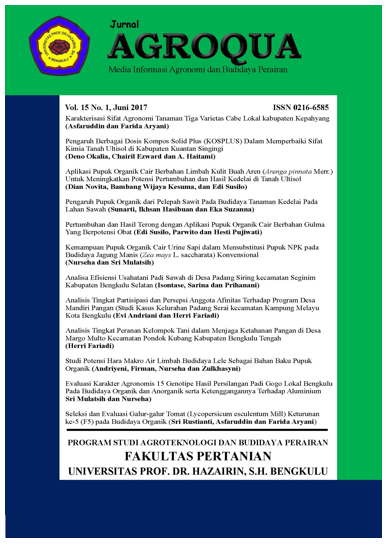ANALISIS HASIL EKSTRAKSI Sargassum sp. DARI TELUK EKAS, PEMICU PENINGKATAN PRODUKSI RUMPUT LAUT, LOMBOK TIMUR, NUSA TENGGARA BARAT
DOI:
https://doi.org/10.32663/ja.v19i1.1689Keywords:
Ekas gulf, extraction, production, proximate analysis, Sargassum spAbstract
West Nusa Tenggara (NTB) Province is one of the seaweed production centers in Indonesia. However, the production of seaweed cultivation has various obstacles, one of which is the quality of the seeds and the growth rate of the thallus which tends to decline. Soaking Eucheuma cottonii seeds using seaweed extracts from Sargassum aquifolium, Ulva lactuca, Turbinaria sp. was able to improve seed quality and production of Eucheuma cottonii. The purpose of this study was to determine the extracted content of Sargassum sp. from the Ekas Gulf, East Lombok, NTB. The method in this study used proximate analysis of Sargassum sp., alginate analysis using the Fourier Transformed Infra-Red (FT-IR) test. The content of N, P, and K substances, water, ash, minerals Fe, Ca, fat and carbohydrates from the dry sample of Sargassum aquifolium taken from Ekas Gulf was 7.22; 0.18; 6,70,12,79; 28.89; 0.12; 3.34; -8.41 and 59.51%. Yield and FT-IR alginate samples were 20%; the hydroxyl group (-OH) at wave number 3467.1 cm -1, 1419.3 cm -1, the carbonyl group (saturated cyclic COC) at the number 1114.04 cm -1.1030.2 cm -1 and the typical CH group pyranose at 880.37 cm -1. Sargassum sp. can increase Eucheuma production by soaking seeds before sowing because they contain many minerals that are needed for eucheuma for growth and development.
References
Downloads
Published
Issue
Section
License
Authors who publish with this journal agree to the following terms:
- Authors grant the journal right of first publication with the work simultaneously licensed under a Creative Commons Attribution 4.0 Internasional (CC BY 4.0) Licence that allows others to use and share the work with an acknowledgment of the work's authorship and initial publication in this journal.
- The author(s) still hold the copyright of his/her/their work and retain publishing rights without restrictions such as (but not limited to) patent right, lecture, book and reproduce the article for own purposes.
















